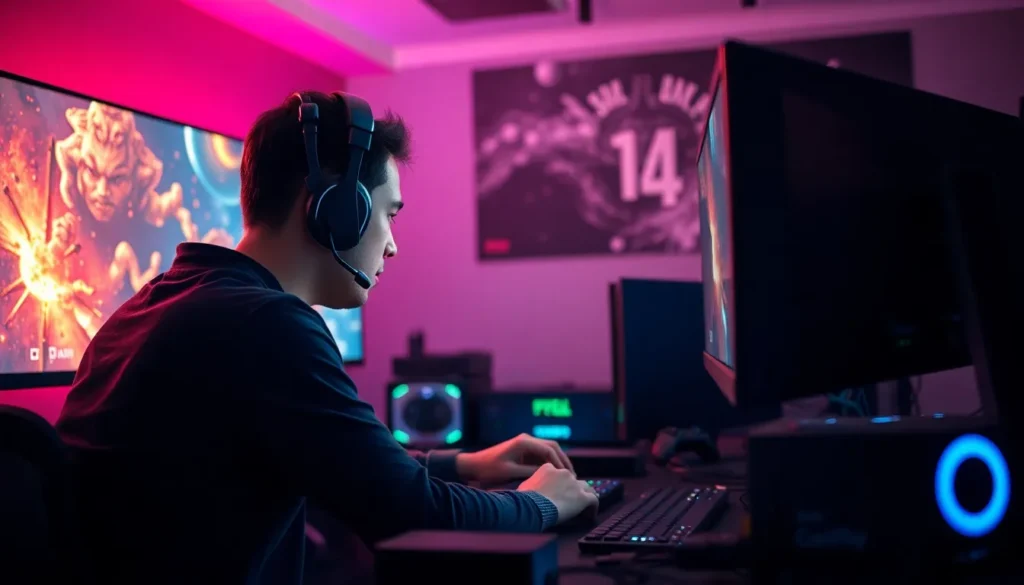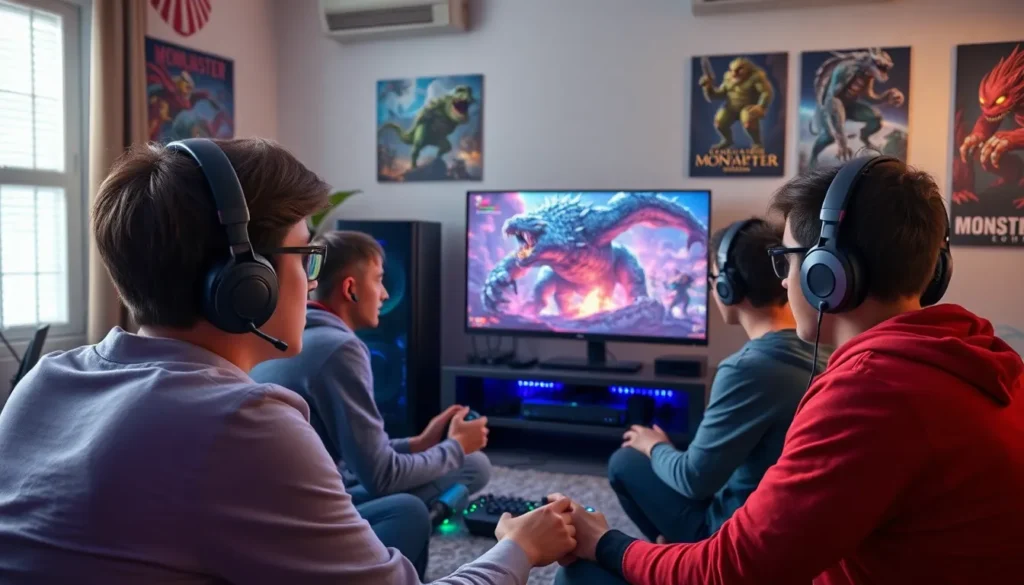In the epic showdown of HDMI versus DisplayPort, gamers everywhere are left scratching their heads. It’s like choosing between pizza and tacos—both are great, but which one will fuel your gaming marathon? With the stakes higher than a final boss battle, understanding the differences can mean the difference between smooth gameplay and a pixelated nightmare.
HDMI Overview
HDMI, or High-Definition Multimedia Interface, plays a crucial role in modern gaming. It’s widely adopted in both consoles and PC setups, making it essential to understand its features and advantages.
Features of HDMI
HDMI supports high-definition video and multi-channel audio through a single cable. Standard versions handle resolutions up to 4K at 60Hz, while newer versions like HDMI 2.1 can support 8K at 60Hz and even 4K at 120Hz. It also includes features like Consumer Electronics Control, allowing control of multiple devices through one remote. Additional capabilities include Audio Return Channel, enhancing audio transmission from the TV back to an audio receiver. These features enhance overall user experience, catering specifically to gaming needs.
Advantages of HDMI for Gaming
HDMI offers several advantages tailored to gamers. First, HDMI is compatible with most gaming consoles, ensuring easy connectivity. Its support for variable refresh rates helps eliminate screen tearing, promoting smoother gameplay. Many modern GPUs come equipped with HDMI outputs, facilitating high refresh rates at 4K resolutions. Additionally, gamers benefit from quick-switch capabilities, allowing them to change sources without delay. Overall, HDMI provides a seamless experience for gamers, balancing convenience and performance effectively.
DisplayPort Overview

DisplayPort serves as a digital display interface, designed to connect video sources to displays. This technology supports high-resolution video and audio, making it a viable option for gamers seeking optimal performance.
Features of DisplayPort
DisplayPort supports multiple displays through a single output. This flexibility allows for daisy-chaining, connecting multiple monitors effortlessly. It handles high resolutions, with capabilities reaching up to 8K at 60Hz, and 4K at refresh rates exceeding 144Hz. Additionally, DisplayPort supports a feature called Adaptive Sync, which reduces screen tearing and stuttering. Enhanced audio capabilities ensure that gamers experience immersive sound quality.
Advantages of DisplayPort for Gaming
DisplayPort offers significant advantages tailored for gamers. Low latency improves responsiveness, enhancing gameplay. Compatibility with G-Sync and FreeSync technologies reduces visual tearing, allowing for vertical synchronization. The robust bandwidth of DisplayPort, up to 32.4 Gbps, permits high frame rates without sacrifice. DisplayPort also includes Multi-Stream Transport, enabling multi-monitor setups without requiring additional ports. These benefits make DisplayPort an excellent choice for competitive gaming and immersive experiences.
Key Differences Between HDMI and DisplayPort
Understanding the distinctions between HDMI and DisplayPort helps gamers make informed choices. Both interfaces offer unique features impacting gaming performance.
Resolution and Refresh Rate
Resolution and refresh rate play crucial roles in the gaming experience. HDMI handles resolutions up to 8K at 60Hz with the HDMI 2.1 version. In contrast, DisplayPort supports similar resolutions but excels in high refresh rates, managing 4K at refresh rates exceeding 144Hz. HDMI is compatible with most consoles, making it ideal for casual gamers. Competitive gamers often prefer DisplayPort for its superior refresh capabilities, enhancing gameplay fluidity. The ability to support higher frame rates can mean the difference between victory and defeat in fast-paced games.
Audio Support
Audio support varies between the two interfaces. HDMI offers multi-channel audio capabilities, allowing for immersive sound experiences without extra cabling. It supports advanced audio formats, which enhance the overall gaming atmosphere. DisplayPort provides robust audio support as well. It offers several channels of audio while maintaining high quality. Both HDMI and DisplayPort cater to diverse audio requirements, ensuring gamers enjoy rich soundscapes. Gamers focusing on audio quality and seamless integration will benefit from either option, depending on their specific setups and devices.
Which Is Better for Gaming?
The choice between HDMI and DisplayPort significantly impacts gaming experiences. Differences in performance and compatibility dictate which option suits individual setups best.
Performance Considerations
Performance stands as a key factor in this debate. DisplayPort often delivers higher refresh rates, supporting 4K at over 144Hz, ideal for competitive gamers. HDMI, while capable of 8K at 60Hz with version 2.1, generally offers lower refresh rates for 4K. Adaptive Sync technology in DisplayPort minimizes screen tearing and stuttering, enhancing smoothness in fast-paced games. Latency tends to be lower with DisplayPort as well, making it a preferred choice for competitive scenarios. HDMI supports variable refresh rates, but DisplayPort provides more robust options for maintaining fluid gameplay.
Compatibility with Devices
Compatibility plays an integral role in device selection. HDMI maintains widespread adoption across various gaming consoles, making it an easy choice for console gamers. Most TVs and monitors support HDMI, providing versatility for different setups. DisplayPort, meanwhile, boasts compatibility with high-end monitors and gaming PCs, particularly those equipped for ultra HD gaming. It allows for daisy-chaining multiple displays, benefiting users who seek expansive setups. Understanding device compatibility ensures gamers choose the right interface for optimal performance, whether on consoles or high-performance PCs.
Conclusion
Choosing between HDMI and DisplayPort for gaming ultimately depends on individual needs and preferences. For gamers seeking high refresh rates and low latency competitive play DisplayPort shines with its superior capabilities. On the other hand HDMI offers broad compatibility and convenience particularly for console gamers.
Both options provide excellent audio and video quality ensuring an immersive gaming experience. By understanding the strengths of each interface gamers can make informed decisions that enhance their overall gameplay. Whether opting for the versatility of HDMI or the performance edge of DisplayPort the right choice can elevate gaming to new heights.



